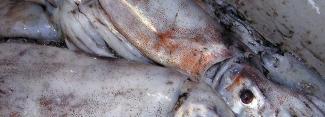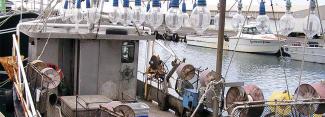The Southern Squid Jig Fishery is a low impact, single method, single species fishery that covers almost half of the Australian Fishing Zone.
AFMA manages squid boats by limiting effort, restricting how many boats can fish in the area of the fishery and regulating what gear they can use.



Target Species
| Species | Fishing Mortality* | Biomass** |
|---|---|---|
|
Gould's squid also known as arrow squid Nototodarus gouldi |
G;Not subject to overfishing | G;Not overfished |
* Fishing mortality status relates to the level of fishing pressure on a stock - specifically, whether fishing mortality in the year being assessed is likely to result in the stock becoming overfished, or prevent the stock from rebuilding from an overfished state. If fishing mortality exceeds either of these thresholds, a stock is considered to be subject to overfishing.
** Biomass status relates to how many fish there are - specifically, whether the biomass in the year being assessed is above the level at which the risk to the stock is considered to be unacceptable. The HSP defines this level as the limit reference point, below which the stock is considered to be overfished.
Gear allowance
| Species | 2023 gear allowance | 2022 gear allowance | 2021 gear allowance | 2020 gear allowance |
|---|---|---|---|---|
| Gould’s squid | 550 standard squid jigging machines | 550 standard squid jigging machines | 550 standard squid jigging machines | 550 standard squid jigging machines |
Total fishery value
$A 0.9 million (2015).
Fishing gear
Read more about squid jig.
Location
The Southern Squid Jig Fishery is located off New South Wales, Victoria, Tasmania and South Australia and in a small area of oceanic water off southern Queensland.
Major landing ports
- Portland (Victoria)
- Queenscliff (Victoria)
- Triabunna (Tasmania)
Markets supplied
- Fresh product – domestic (primarily Melbourne)
- Frozen product – international (China, Hong Kong, Canada)
Fishing season
12 month season, beginning on 1 January.
Management of catch
The Southern Squid Jig Fishery is a low impact, single method, single species fishery that covers almost half of the Australian Fishing Zone.
AFMA manages squid boats by limiting effort, restricting how many boats can fish in the area of the fishery and regulating what gear they can use.
Each year AFMA sets the total allowable effort for the year. The total allowable effort determines the total number of standard squid jigging machines that can be used in the fishery for the year. Setting an effort limit is one of the main methods AFMA uses to ensure that squid catches remain sustainable.
To determine what the effort should be, a number of sources of information are used. AFMA and scientists have developed the Southern Squid Jig Fishery Harvest Strategy, which looks at the catch and effort data in the fishery, environmental aspects and other available scientific information.
The effort set is based on the sustainability of the species, the amount that can be taken out of the ocean each year without causing a decline in the species over time. Consideration is also given to the economic yield to maximise economic returns from the fishery.
Licence to fish
All operators in the Southern Squid Jig Fishery have been granted statutory fishing rights that allow them to fish in the fishery and catch squid. These rights are transferable between fishers. Under these arrangements, each fisher is limited to only fish using the amount of effort they hold and the whole fishery is limited to the total allowable effort that is set each season.
Collecting data
Data about the catch and effort of the fishery is collected from the logbooks fishers have to fill out for every fishing shot. Logbooks record:
- the species and amount caught
- catch that is discarded
- the catch/release of any protected species and their life status
- set and haul times of each shot
- the location of each shot
- the type and amount of gear used.
Species sustainability
As the species caught in this fishery are also caught by a number of other countries, they are assessed at a global level.
The current sustainability status is:
Australia (ABARES 2016):
- Gould’s squid – Not overfished and not subject to overfishing.
Species risk assessments
AFMA regularly monitor the effects fishing activities have on marine species, habitats and communities through ecological risk assessments. The assessment results help to prioritise the management, research, data collection and monitoring needs for the fishery.
After the risk assessment is complete, an ecological risk management strategy is developed to address how AFMA will manage marine species, habitats and communities identified in the assessment as greatly impacted by commercial fishing operations.
Read the most recent assessment and strategy for the Southern Squid Jig Fishery.
Bycatch work plans
A bycatch and discarding workplan outlines ways to minimise the bycatch of species that are at a high risk of being caught as bycatch in the fishery. These species can include threatened, endangered and protected species, sharks and other non-target fish species.
View the Southern Squid Jig Fishery Bycatch and Discard Workplan.
Harvest strategy
A harvest strategy is used to help determine what the quota should be for the target species of the fishery. Fishing, environmental and economic information is included in the harvest strategy, which helps to monitor and maintain the sustainability of the targeted species.
All harvest strategies are developed in line with the Commonwealth Fisheries Harvest Strategy Policy and Guidelines.
Read the Southern Squid Jig Fishery Harvest Strategy.
Export approval
To export from an Australian commercial fishery, the fishery must be accredited by the Department of Climate Change, Energy, the Environment and Water under the Environment Protection and Biodiversity Conservation Act 1999 (EPBC Act).
Conditions and recommendations that must be adhered to during the most recent accreditation period can be found on the Department of Climate Change, Energy, the Environment and Water website.
Marine reserves
Commonwealth marine reserves are areas established under Australian environment law to help conserve the spectacular marine life in our oceans. They allow ecologically sustainable use of our marine resources and provide special places for people to enjoy and appreciate the fantastic diversity of our marine habitats.
Marine reserves are sometimes known as marine protected areas or marine parks and are managed by the Department of Climate Change, Energy, the Environment and Water.
More information about marine reserves can be found on the Department of Climate Change, Energy, the Environment and Water.
Fishing in the fishery
Fishing operators wanting to fish in the Southern Squid Jig Fishery must hold quota statutory fishing rights for all target species in the fishery.
Download a copy of the Southern Squid Jig Fishery Management Arrangements Booklet for a full description of all fishing requirements in the fishery.
Fishery legislation
The management of the fishery is also governed by legislation.
Management plan
The Southern Squid Jig Fishery Management Plan 2005.
Fishery Determinations
The Southern Squid Jig Fishery (Total Allowable Effort) Determination 2022.
We recognise that fisheries management involves a broad range of stakeholders.
Here are just a few ways we are working with our stakeholders, who include industry, scientists, environmental groups and the community for an informed approach to fisheries management.
Fishing industry
Each fishing season, AFMA officers discuss current trends in fishing and catches with industry members on advisory groups and with operators in port. All this information is useful for the continuing management of the fishery.
Southern Squid Jig Fishery Resource Assessment Group
The main role of the Southern Squid Jig Fishery Resource Assessment Group is to provide advice on the status of the squid stock, the impact of squid fishing on the marine environment and strategic research priorities. This group also uses the Southern Squid Jig Fishery Harvest Strategy to provide annual recommended total allowable effort limits for squid catches in the upcoming season. This recommended effort limit is provided as advice to the South East Management Advisory Committee and the AFMA Commission. The Southern Squid Jig Resource Assessment Group advice and recommendations contribute to determining the annual total allowable effort limits for the fishery.
See the Southern Squid Resource Assessment Group webpage for a summary of the latest discussions and outcomes from the committee.
South East Management Advisory Committee
The South East Management Advisory Committee is the management advisory body for the Southern Squid Jig Fishery. The committee includes representatives from AFMA, scientific agencies, environmental non-government organisations, the recreational/charter fishing sector and state governments. The committee holds four to five meetings each year to discuss sustainable catch limits and strategic management issues.
See the South East Management Advisory Committee webpage for a summary of the latest discussions and outcomes from the group.
Recreational fishers
Many of the fish species caught by commercial fishers in the fishery are also caught by recreational fishers. The recreational fishing of these species is managed by the state governments.
Government departments
AFMA works closely with other government departments, such as the Department of Agriculture, Fisheries and Forestry and the Department of Climate Change, Energy, the Environment and Water. They help in providing advice and guidance on both domestic and international fisheries issues.
State governments
The Australian state governments manage fishing from the Australian coast out to three nautical miles. Occasionally there is some overlap in fishing operations between the state and commonwealth jurisdictions and AFMA regularly communicates with the state fisheries agencies to manage any problems.
Representatives from the state fisheries agencies also attend the South East Management Advisory Committee meetings and provide input and advice.
Environmental non-government organisations
Representatives from environmental non-government organisations attend the South East Management Advisory Committee meetings and provide input and advice.
Management publications
Southern Squid Jig Fishery – management arrangements booklet
Southern Squid Jig Fishery Management Plan 2005
Environment publications
Ecological risk management reports
Harvest Strategy – Southern Squid Jig Fishery
Research and data publications

AFMA uses many methods to monitor the compliance of fishing activities and collect data on fish stocks. These include:
Onboard observers
One of the main monitoring methods used by AFMA is onboard scientific observers. These observers are people employed by AFMA to go out on boats and independently record the catch, effort and biological information of each fishing trip.
They take samples from fish, such as the otoliths or ear bones, and use these to determine the age of the fish caught.
Observers also record the length, weight and sex of each fish caught during a trip and report on the other wildlife that may be seen, the weather conditions, the composition of commercial catch fate of species that are caught as bycatch.
Boats in the fishery must carry an AFMA observer when requested by AFMA.
Read more about the Observer program.
Satellite tracking
A satellite monitoring system called a Vessel Monitoring System or VMS for short, is fitted to each concession holders boat. This system helps AFMA to monitor vessel position, course and speed. The tracking unit regularly transmits the information through a communications satellite to a land earth station. This information is sent by secure internet connection to a database at AFMA.
Read more about our satellite tracking program.
Cameras on fishing boats – electronic monitoring
AFMA has electronic monitoring systems on some fishing boats. These systems have sensors linked to surveillance cameras that record fishing activity such as the impacts of some fishing methods on protected species. These recordings can then be collected and monitored by AFMA. Electronic monitoring gives fishers a cost effective way to support monitoring and data collection.
Read more about electronic monitoring of fishing boats.